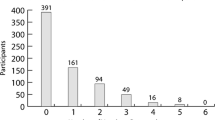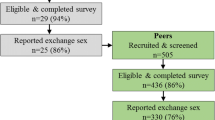Abstract
Evidence suggests that respondent-driven sampling (RDS) is an efficient approach to sampling among varied populations of adult men who have sex with men (MSM) both in the USA and abroad, although no studies have yet evaluated its performance among younger MSM, a population with a steep rise in HIV infection in recent years. Young MSM (YMSM) may differ in terms of their connectedness to other YMSM (e.g., due to evolving sexual identity, internalization of sexual minority stigma, and lack of disclosure to others) and mobility (e.g., due to parental monitoring) which may inhibit the sampling process. The aims of this study were to evaluate the efficiency and effectiveness of RDS-based sampling among young urban MSM and to identify factors associated with recruitment success. We hypothesized that demographic, social, behavioral, and network factors, including racial/ethnic minority status, homelessness (i.e., as an indicator of socioeconomic marginalization), HIV-positive status, substance use problems, gay community connectedness, and network size would be positively related to recruitment productivity, while sexual minority stigmatization, environmental barriers (e.g., parental monitoring), and meeting sex partners on the internet (i.e., virtual venue) would be negatively related to recruitment productivity. Between December 2009 and February 2013, we used RDS to recruit a sample of 450 YMSM, ages 16–20. Findings suggest that the use of RDS for sampling among YMSM is challenging and may not be feasible based on the slow pace of recruitment and low recruitment productivity. A large number of seeds (38 % of the sample, n = 172) had to be added to the sample to maintain a reasonable pace of recruitment, which makes use of the sample for RDS-based population estimates questionable. In addition, the prevalence of short recruitment chains and segmentation in patterns of recruitment by race/ethnicity further hamper the network recruitment process. Thus, RDS was not particularly efficient in terms of the rate of recruitment or effective in generating a representative sample. Hypotheses regarding factors associated with recruitment success were supported for network size and internalized stigma (but not other factors), suggesting that participants with larger network sizes or high levels of internalized stigma may have more and less success recruiting others, respectively.



Similar content being viewed by others
References
Heckathorn DD. Respondent-driven sampling: a new approach to the study of hidden populations. Soc Probl. 1997; 44(2): 174–99.
Heckathorn DD. Respondent-driven sampling II: deriving valid population estimates from chain-referral samples of hidden populations. Soc Probl. 2002; 49(1): 11–34.
Respondent-Driven Sampling Analysis Tool (RDSAT) [computer program]. Version 7.1. Ithaca, NY: Cornell University; 2012.
Salganick M. Respondent-driven sampling in the real world. Epidemiology. 2012; 23(1): 148–50.
Simic M, Johnston LG, Platt L, Baros S, Andjelkovic V, Novotny T, Rhodes T. Exploring barriers to ‘respondent driven sampling’ in sex worker and drug-injecting sex worker populations in Eastern Europe. J Urban Health. 2006; 83(6 Suppl): i6–15.
McCreesh N, Frost SD, Seeley J, et al. Evaluation of respondent-driven sampling. Epidemiology. 2012; 23(1): 138–47.
Deiss RG, Brouwer KC, Ma OL, et al. High-risk sexual and drug using behaviors among male injection drug users who have sex with men in 2 Mexico-US border cities. Sex Transm Dis. 2008; 35(3): 243–9.
Iguchi MY, Ober AJ, Berry SH, et al. Simultaneous recruitment of drug users and men who have sex with men in the United States and Russia using respondent-driven sampling: sampling methods and implications. J Urban Health. 2009; 86: S5–31.
Ramirez-Valles J, Garcia D, Campbell RT, Diaz RM, Heckathorn DD. HIV infection, sexual risk behavior, and substance use among Latino gay and bisexual men and transgender persons. Am J Public Health. 2008; 98(6): 1036–42.
Ramirez-Valles J, Heckathorn DD, Vazquez R, Diaz RM, Campbell RT. From networks to populations: the development and application of respondent-driven sampling among IDUs and Latino gay men. AIDS Behav. 2005; 9(4): 387–402.
Rhodes SD, McCoy TP, Hergenrather KC, et al. Prevalence estimates of health risk behaviors of immigrant Latino men who have sex with men. J Rural Health Off J Am Rural Health Assoc Natl Rural Health Care Assoc. 2012; 28(1): 73–83.
Johnston L, Whitehead S, Simic-Lawson M, Kendall C. Formative research to optimize respondent-driven sampling surveys among hard-to-reach populations in HIV behavioral and biological surveillance: lessons learned from four case studies. AIDS Care. 2010; 22(6): 784–92.
Chua AC, Chen MI, Cavailler P, et al. Challenges of respondent driven sampling to assess sexual behaviour and estimate the prevalence of human immunodeficiency virus (HIV) and syphilis in men who have sex with men (MSM) in Singapore. Ann Acad Med. 2013; 42(7): 350–3. Singapore.
Toledo L, Codeço CT, Bertoni N, et al. Putting respondent-driven sampling on the map: insights from Rio de Janeiro, Brazil. J Acquir Immune Defic Syndr. 2011; 57(Suppl 3): S136–43.
Kral AH, Malekinejad M, Vaudrey J, et al. Comparing respondent-driven sampling and targeted sampling methods of recruiting injection drug users in San Francisco. J Urban Health Bull N Y Acad Med. 2010; 87(5): 839–50.
Burt RD, Hagan H, Sabin K, Thiede H. Evaluating respondent-driven sampling in a major metropolitan area: comparing injection drug users in the 2005 Seattle area national HIV behavioral surveillance system survey with participants in the RAVEN and Kiwi studies. Ann Epidemiol. 2010; 20(2): 159–67.
McCreesh N, Johnston LG, Copas A, et al. Evaluation of the role of location and distance in recruitment in respondent-driven sampling. Int J Health Geogr. 2011; 10: 56.
Jenkins RA. Recruiting substance-using men who have sex with men into HIV prevention research: current status and future directions. AIDS Behav. 2012; 16(6): 1411–9.
Reisner SL, Mimiaga MJ, Johnson CV, et al. What makes a respondent-driven sampling “seed” productive? Example of finding at-risk Massachusetts men who have sex with men. J Urban Health Bull N Y Acad Med. 2010; 87(3): 467–79.
Wei C, McFarland W, Colfax GN, Fuqua V, Raymond HF. Reaching black men who have sex with men: a comparison between respondent-driven sampling and time-location sampling. Sex Transm Infect. 2012; 88(8): 622–6.
Lauby JL, Millett GA, LaPollo AB, Bond L, Murrill CS, Marks G. Sexual risk behaviors of HIV-positive, HIV-negative, and serostatus-unknown Black men who have sex with men and women. Arch Sex Behav. 2008; 37(5): 708–19.
Shoptaw S, Weiss RE, Munjas B, et al. Homonegativity, substance use, sexual risk behaviors, and HIV status in poor and ethnic men who have sex with men in Los Angeles. J Urban Health Bull N Y Acad Med. 2009; 86(Suppl 1): 77–92.
Kuhns L, Johnson A, Mustanski B, Garofalo R. Barriers to and facilitators of optimal functioning of respondent-driven sampling for recruitment of young men who have sex with men (YMSM) into HIV-related research. Paper presented at: Annual Meeting of the American Public Health Association (APHA) 2011; Washington, DC.
Ramirez-Valles J, Kuhns LM, Campbell RT, Diaz RM. Social integration and health: community involvement, stigmatized identities, and sexual risk in Latino sexual minorities. J Health Soc Behav. 2010; 51(1): 30–47.
Nappi CMTC, Kapungu C, et al. Parental monitoring as a moderator of the effect of family sexual communication on sexual risk behavior among adolescents in psychiatric care. AIDS Behav. 2009; 13: 1012–20.
Newcomb ME, Ryan DT, Garofalo R, Mustanski B. The effects of sexual partnership and relationship characteristics on three sexual risk variables in young men who have sex with men. Arch Sex Behav. 2014; 43(1): 61–72.
National Institute on Alcohol Abuse and Alcoholism Task Force on Recommended Alcohol Questions. National Council on Alcohol Abuse and Alcoholism Recommended Sets of Alcohol Consumption Questions. Bethesda, MD: National Institute on Alcohol Abuse and Alcoholism; October 15–16 2003.
Salganik M, Heckathorn DD. Sampling and estimation in hidden populations using respondent-driven sampling. Sociol Methodol. 2004; 34: 193–240.
Phillips G, Kuhns LM, Garofalo R, Mustanski B. Do recruitment patterns of young men who have sex with men (YMSM) through respondent-driven sampling (RDS) violate assumptions? Manuscript under review.
Mustanski B, Birkett M, Greene GJ, Rosario M, Bostwick W, Everett BG. The association between sexual orientation identity and behavior across race/ethnicity, sex, and age in a probability sample of high school students. Am J Public Health. 2014; 104(2): 237–44.
Truong HH, Grasso M, Chen YH, et al. Balancing theory and practice in respondent-driven sampling: a case study of innovations developed to overcome recruitment challenges. PLoS One. 2013; 8(8): e70344.
Mustanski BS, Garofalo R, Emerson EM. Mental health disorders, psychological distress, and suicidality in a diverse sample of lesbian, gay, bisexual, and transgender youths. Am J Public Health. 2010; 100(12): 2426–32.
Mustanski B, Birkett M, Kuhns L, Muth S, Latkin C. The role of geographic and network factors in racial disparities in HIV among young men who have sex with men: an egocentric network study. Manuscript under review.
Marks G, Millett GA, Bingham T, et al. Understanding differences in HIV sexual transmission among Latino and black men who have sex with men: the Brothers y Hermanos Study. AIDS Behav. 2009; 13(4): 682–90.
Glaeser E, Vigdor J. The end of the segregated century: racial segregation in America’s neighborhoods, 1890–2010. New York: Manhattan Institute for Policy Research; 2012.
Acknowledgments
Thanks to the staff and participants of “Crew450” for their time and effort. Research reported in this publication was supported by the National Institute on Drug Abuse of the National Institutes of Health under Award Number R01DA025548. The content is solely the responsibility of the authors and does not necessarily represent the official views of the National Institutes of Health.
Author information
Authors and Affiliations
Corresponding author
Rights and permissions
About this article
Cite this article
Kuhns, L.M., Kwon, S., Ryan, D.T. et al. Evaluation of Respondent-Driven Sampling in a Study of Urban Young Men Who Have Sex with Men. J Urban Health 92, 151–167 (2015). https://doi.org/10.1007/s11524-014-9897-0
Published:
Issue Date:
DOI: https://doi.org/10.1007/s11524-014-9897-0




